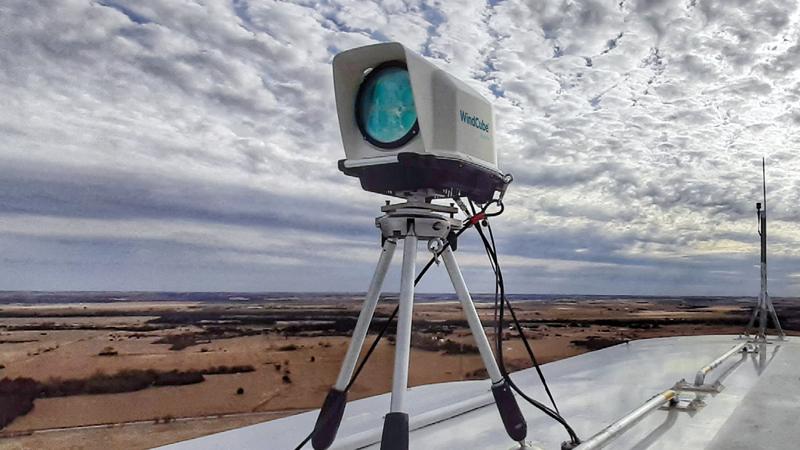Gaining ground in Oklahoma
Four key wind energy industry players validate WindCube Nacelle lidar according to IEC 61400-50-3
Project highlights
Location: Oklahoma, USA
Technology: One WindCube Nacelle, one IEC met mast, one WindCube ground-based lidar Campaign: Three months, comparing the accuracy of all three wind measurement technologies
Results: WindCube Nacelle demonstrates accurate power curve measurements in line with the IEC-61400-50-3 standard
The Client: DNV, ENGIE North America, and GE Renewable Energy together with Vaisala
Vaisala provided: WindCube® Nacelle lidar
The challenge: See how the technology measures up
As turbines and the wind energy industry keep growing, Power Performance Testing (PPT) and verification become even more important: Underperformance equates to reduced power output and lost revenue. Can nacelle- mounted lidar, measuring directly upwind of the nacelle, provide a complete testing solution?
Four key wind energy organizations teamed up for a three-month wind energy measurement campaign to answer the question. The team from ENGIE North America, GE Renewable Energy, DNV and Vaisala launched the campaign to see how nacelle- mounted lidar would compare with other technologies — especially from an operational and cost perspective. "Power performance measurements are actually quite costly, both for projects in flat and complex terrain," said Hong Liu, ENGIE North America. "In order to optimize our PPT program, we try to maximize our benefits and reduce the costs."
The campaign took place at a 250 MW wind farm in Oklahoma owned by ENGIE North America, and included one nacelle-based lidar, one ground-based lidar and one IEC met mast. In addition to comparing technologies, the campaign would advance the team’s operational experience of nacelle-mounted lidar—first in flat terrain, later in complex terrain—and help define installation guidelines now available for future projects on GE 2 MW turbines.
The solution: Conduct an IEC standards- based campaign
The team chose the WindCube Nacelle lidar, notably because of its reputation for high accuracy, reliability, flexible measurement range and cost efficiency compared with met masts or ground-based lidar co-located with a small met mast. The WindCube Nacelle was installed on a 2.82 MW, 127m diameter, 89m hub height wind turbine, in its standard 4-beams configuration, positioned and mounted according to GE Renewable Energy recommendations. A permanent 89m IEC met mast and ground- based WindCube vertical lidar were located respectively at 282m (2.2D) and 290m (2.3D) from the turbine. The team tested four turbines during this 3-month campaign.
Lidar data availability is one of the key indicators for accurate PPT. IEC standards and industry best practices recommend to measure the wind between 2D and 4D, and at 2.5D if possible. High data availability was shown between 2D and 4D during the campaign: At 2.5D the WindCube Nacelle data availability is 88.6%, which enables accurate measurement for PPT.
The results: A clear winner for PPT
The graphs below show the power curves measured with the met mast and WindCube Nacelle: The power curve is clearly less scattered with the lidar. Horizontal wind speed measurement comparison was also performed: The right graph shows the correlation between the two instruments.
Also, the standard deviation was smaller for the WindCube Nacelle. This highlights the advantage of the nacelle-mounted lidar by constantly measuring the wind in front of the wind turbine.
The campaign results prove the WindCube Nacelle provides accurate wind measurements relative to concurrent IEC- compliant measurement instruments. Lower uncertainty was achieved due to better spatial coherence of nacelle lidar measurements.
The group has gained high confidence in performing PPT using WindCube Nacelle and ensured a cost-effective and straightforward approach throughout installation, data collections and data analysis. "It was nice to get the experience in this campaign, where we could see lower scatter in the nacelle lidar-based power curve, lower standard deviation, and lower category A uncertainty from an IEC perspective," said Alex James, GE Renewable Energy.
"The tangible result is that we feel comfortable using [nacelle mounted lidar] to do PPT," added Hong Liu. "All three approaches show quite identical results and that made us feel very comfortable to use it moving forward. Another aspect is the PPT results variations upwind of the turbine: That is a very good aspect for us to understand."
WindCube Nacelle is the first nacelle-mounted lidar classified according to the new IEC 61400- 50-3 standard. These results are compelling evidence of the technical suitability and market readiness of using nacelle-mounted lidars for PPT in accordance with the standard.

